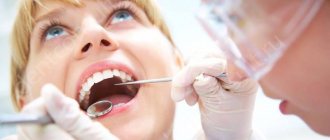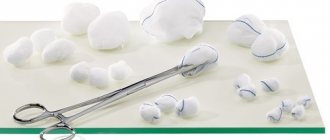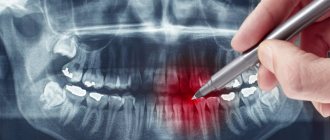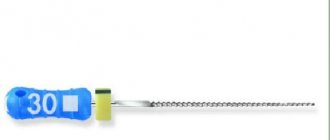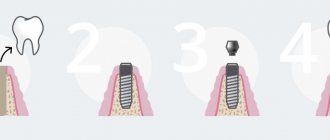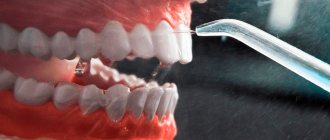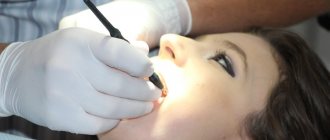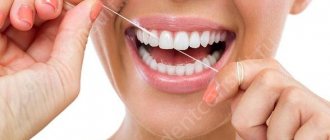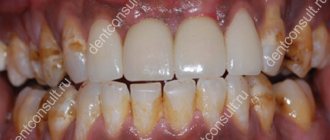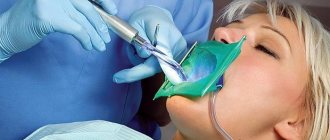Gum coagulation is a surgical procedure that involves cutting off the soft tissue of the gums using a heated instrument.
In other words, gum coagulation is plastic surgery using electric current. Moreover, the procedure is completely bloodless and as safe as possible (compared to a scalpel). The coagulation method is widely used for the resection of malignant and benign tumors, as well as a number of other diseases.
What is gum coagulation in dentistry?
The procedure is otherwise called cauterization. In dental practice, it is used mainly for excision of excess gums. It is similar to gingivectomy, but less traumatic. Using instruments that apply electric current or laser radiation, excess gum tissue is removed through coagulation - the sticking together of particles.
When exposed to high temperatures, protein and blood clot. Excess mucous membrane is cut off, the rest shrinks and becomes smaller. After the operation, the edges of the gums surrounding the tooth are aligned and become aesthetically pleasing.
The procedure is absolutely painless as it is performed under local anesthesia. There is no blood or risk of infection. The rehabilitation period is easy and short, as wounds heal quickly.
Unlike gingivoplasty, which can be used to close gum recession, it does not replace the missing tissue volume. Plastic surgery is primarily done to correct gingival contours and lift gums during atrophy.
How does the procedure work?
Coagulation of the gums is carried out by a dental surgeon under local anesthesia. The coagulation procedure (especially using a laser) is almost painless, so a special anesthetic gel is sufficient for complete pain relief.
During the operation, the patient must sit quietly in a chair - sudden movements can damage healthy tissues of the oral mucosa. Using a laser or coagulator, the doctor excises the required areas of tissue. If we are talking about a neoplasm, then it is completely removed.
The entire operation lasts on average 10-20 minutes - the duration directly depends on the method and complexity. For several hours after coagulation, you should not eat hard or hot food, which can further injure the wound. It is also necessary to maintain oral hygiene. For quick healing, it is recommended to rinse your mouth with soothing infusions (oak bark, chamomile, etc.).
Types of coagulation
The operation is performed using two devices: an electrocoagulator or a laser. Using a heated metal tool is an outdated but possible method. Laser therapy is more gentle compared to its predecessors.
Cauterization of gums in dental clinics is carried out using two methods:
- Monopolar. It is performed using an electrical device - a monopolar coagulator. Alternating current with high-frequency oscillations is supplied to the electrode, and through it into the tissue. It then passes through the body and returns to the end plate. In this case, coagulation occurs in a certain area. The procedure is safe and does not have a negative effect on the body.
- Bipolar. The tip of the electrocoagulator is bifurcated and does not have a closing plate. The current only affects the tissue sandwiched between the two ends that supply the electricity.
The bipolar technique is simpler and safer, but can only be used to remove small formations. Monopolar is suitable for all cases, but carries some risks. A burn may occur due to equipment malfunction or medical error. However, modern clinics are equipped with good equipment and experienced doctors, so you should not be afraid of the procedure.
Alternative methods of performing the procedure
Removal of hard dental deposits in the pocket cavity can be done in various ways. A significant part of them can be classified as a closed type of operation, because their use does not involve any incisions in the gums.
Vacuum curettage in dentistry
The periodontal cavity is cleaned here with special curettes, which are connected to a vacuum suction device for separated particles from the treatment area. Fewer injuries and instant removal of tissue particles and plaque reduce the risk of complications and shorten the rehabilitation period.
Chemical
This technique uses various chemicals (particularly citric acid) to soften and then remove hard plaque particles. The solution has not only a cleansing and softening effect, but also an antiseptic, making it easier and with less damage to remove all excess from the gum pocket, while simultaneously disinfecting the cavity and reducing the likelihood of infection.
Ultrasonic
The method of destroying hard dental deposits using ultrasound requires the use of special equipment, for example, the Vector apparatus. Using ultrasound, as well as a water-air jet under pressure, it allows you to successfully remove hard plaque, although ordinary hand tools are also used for curettage.
Cryo method
The use of liquid nitrogen to remove various deposits and affected tissues is also practiced when treating periodontal pockets. Freezing also kills pathogens, reduces the risk of complications and makes the entire operation completely bloodless.
Laser
The most frequently asked question from patients is what is laser curettage of periodontal pockets? We answer: laser curettage is one of the most modern methods of cleaning gum pockets, its essence is that the laser beam heats the area of action to a high temperature, instantly burning out foreign inclusions and bacteria, while simultaneously closing the blood capillaries, preventing bleeding. This method causes less tissue trauma, does not require sutures, and shortens the recovery period.
Indications and contraindications
The operation is especially in demand for hypertrophic gingivitis. This is an inflammatory gum disease. If left untreated, soft tissue grows, covering the crown of the tooth. The gingival papilla, which is located between adjacent dental units, is most susceptible to hypertrophy.
Coagulation is carried out in the presence of:
- tissue hyperplasia in gingivitis and other diseases;
- neoplasms: hemangiomas, fibromas, warts;
- abnormalities of gingival tissue;
- periodontitis (root canal coagulation);
- inflammation in periodontal pockets during periodontitis;
- caries on the neck, tooth root.
The list of restrictions includes individual intolerance to electric current, acute infections, exacerbation of chronic diseases, terminal stages of diabetes mellitus or other endocrine disorders, severe pathologies of the heart and blood vessels.
Preparing for surgery
Before the procedure, professional oral hygiene is carried out: removing plaque, removing tartar. If there are concomitant diseases, the patient is referred for examination to specialized doctors. After eliminating contraindications, a treatment date is set.
Before visiting the doctor, you need to eat a hearty meal, since after dental procedures you cannot eat for several hours. It is recommended to quit smoking and alcoholic beverages the day before the procedure. Alcohol and nicotine have a bad effect on blood clotting.
Gingivoplasty - correction of gum contour
June 23, 2021 The cost of the procedure is 2000 rubles
For a beautiful smile, a harmonious relationship between teeth and gums is important. If the front teeth look small and short, and when you smile there is a lot of gum exposed, this is a so-called “gummy” smile. Most of the tooth is under the gum, which is why it looks short.
This problem can be solved quite simply without harm to the teeth and surrounding tissues. A gum correction procedure is carried out, namely the removal of “excess” gum that covers the tooth. This type of gum surgery (or gingivoplasty) can significantly improve the aesthetics of your smile.
Is this intervention painful?
The procedure is performed under local anesthesia and the patient does not feel anything.
Is it possible to predict the outcome of this procedure? What will the gums look like after healing?
Even before treatment begins, the new gum contour is modeled using conventional filling material. It is temporarily applied over the gum, visually lengthening the tooth. And, if the result meets expectations, plastic surgery is performed along the modeled contours. Such modeling allows one to fairly accurately predict the future outcome even before intervention.
Is this procedure harmful to teeth or gums?
During gum surgery, only a small part of it is removed (on average, 0.5-1.5 mm), which can in no way harm either the teeth or gums. The procedure also has no long-term consequences.
Are there any contraindications?
Inflammation of the gums. If there is one, it must first be eliminated.
Why do we use laser to correct gums?
Traditional techniques for excision of excess gum tissue are performed using a surgical scalpel. Laser methods are superior to traditional ones in a number of parameters.
- High precision removal of even minimal amounts of gum tissue with high precision.
- Ability to remove minimal amounts of tissue with high precision.
- Fast recovery after the procedure. The laser beam cauterizes the blood vessels and no stitches are required. The slight swelling disappears within a few days.
- Less traumatic. Much less discomfort for the patient after the procedure.
- Absolute sterility of the procedure.
In what cases is gum correction performed?
- To correct a “gummy smile”
- Uneven, asymmetrical gums. The gum level may be lower on one tooth than on another, giving the appearance that one tooth is longer than the other.
- Preparing the gums before installing veneers, crowns or before teeth whitening procedures to achieve the best aesthetic results.
The procedure is often combined with other dental procedures, such as veneers, dentures, and teeth whitening.
Gum correction + veneers
Gum correction+4 crowns
What to expect after gum correction
There may be some swelling and soreness after the procedure; this is completely normal. This discomfort is minimal. During the first few weeks after the procedure, it is important to continue to practice good oral hygiene, but use caution. The tissue that has been treated may remain sensitive for some time. While recovering from the procedure, you should eat soft foods to avoid worsening your discomfort. Do not use mouthwash with alcohol as it may burn sensitive tissue.
How to perform gum cauterization
The operation is performed by a dental surgeon. The patient is anesthetized with local anesthetics. It is important to relax, as sudden movements will disturb the doctor.
Using an electrocoagulator or laser device, excess gingival tissue is excised and tumors are removed. The procedure time depends on the amount of work, but usually does not exceed a quarter of an hour.
To treat pulpitis or periodontitis, coagulation is carried out through the root canal. If the caries is located below the gum level, the tissue is coagulated to gain access to the affected area. In case of periodontal disease, coagulation of the contents of periodontal pockets is carried out.
Recovery period
You are allowed to eat after 3-4 hours. On the first day, you can eat soft, cold or lukewarm foods. You need to chew on the opposite side.
Hygiene procedures are allowed to be carried out the next day, but with caution. It is recommended to rinse your mouth with antiseptics Chlorhexidine, Miramestin, Furacilin, and treat the mucous membranes in the operated area with Metrogyl-Denta gel. After 5 - 7 days, you can supplement the care with means to accelerate regeneration, for example, sea buckthorn oil.
Cost of gum coagulation
The price consists of several factors: the volume of the operation, cauterization method, equipment (laser device or electrical device), additional services. If there is plaque or tartar, then professional cleaning is required, which is paid separately. The price of cauterization for 1 tooth in Moscow is from 1000 rubles to 4000 rubles and more, depending on the complexity of the case.
Our clinic uses modern equipment and employs dental surgeons with extensive clinical experience. We guarantee painless, high-quality treatment and no complications. Prices are agreed upon with the patient before the operation.
COAGULATORS
Minimally invasive techniques can reduce the traumatic effect on tissue during surgery. Minimal wound surface, no bleeding and safe treatment - all this is possible thanks to high-tech equipment, for example, electrocoagulators.
They are used in various fields of medicine - dentistry, gynecology, surgery, orthopedics, neurosurgery, otolaryngology, as well as dermatology and cosmetology.
Electrocoagulators are also used in dentistry for endodontic treatment, operations on the mucous membranes of the oral cavity, “sealing” tissues and pulp, and draining the canal.
Coagulators have replaced surgeons' scalpels. They guarantee excellent results and patient safety during surgery.
Equipment advantages
The coagulation method has a number of advantages over a conventional scalpel:
- Minimal blood loss. In some cases, the operation is completely bloodless.
- Minimal risk of infection. Thanks to coagulation, the risk of infection is practically reduced to zero.
- Versatility. Electrocoagulators perform many functions (dissection, “sealing” of tissues and vessels, destruction of pathogenic microorganisms, etc.). Therefore, they are used to solve a wide range of problems in different fields of medicine.
- Safety. Modern devices monitor the temperature and automatically turn off after continuous operation for a certain time. For example, the Legrin model from the Italian company Carlo De Giorgi turns off after 6 seconds. This eliminates burns and other complications.
After intervention using an electrocoagulator, the tissues are quickly restored, the rehabilitation period is easier, and no complications arise (for example, inflammation, suppuration, etc.).
How the device works
The work is based on the principle of generating high-frequency electric current and its thermal effect on tissues - the coagulator helps to heat them. Tissues contain protein substances. In the place where the active electrode of the device comes into contact with the tissue, they curl up, that is, coagulate.
If the device operates in a more powerful cutting mode, the liquid contained in the tissue turns into steam. It takes up a large volume, so it tears the tissue - this is the process of dissection, or cutting.
Types of devices
There are several types of devices.
There are portable and stationary models. We offer compact options - Legrin 640/00 and EKps-20-1. They are ergonomic and save space.
There are bipolar and monopolar (electric scalpel) electrodes. In the monopolar model, only one electrode acts on the tissue, as in the EKPS-20-1 model. Manipulations can be carried out on deeper layers.
Bipolar electrodes use two electrodes, and the current coagulates the area between them.
Also among the devices are a thermal stapler and an argon plasma coagulator . The first works on the principle of bipolar coagulation, the second - in a non-contact manner using an argon jet.
How to choose a device for dentistry
The result of treatment depends on the correct choice. Below we will tell you what parameters you need to pay attention to.
- Output power. It affects the quality of cutting tissues of different densities. Therefore, you need to choose a device depending on the area in which you will use it. Coagulators have power from 1 to 400 W. For dentistry, 100 W is sufficient. The Legrin 640/00 model has about 100 W, it can also be used in cosmetology to remove moles and papillomas, and in veterinary medicine. The EKps-20-1 model (Orthos, Russia) has a lower power output, so it is only suitable for dentists. The higher the power, the more expensive the device.
- Model - for the use of electrodes, bipolar or monopolar. Most doctors prefer devices for monopolar electrodes.
- Generator frequency. Choose it depending on what fabrics you are working with. For dentists, the optimal range is 1.5 MHz - 4 GHz. In the EKps-20-1 model, from - 1.76 MHz, that is, optimally suited for dental procedures.
- Number of programs. For example, the Legrin monopolar device both cuts and coagulates.
- Control. Availability of LCD screen, timers, indicators. Available in the Legrin model.
- Operation and Maintenance. Rate how clear the device interface is for you. Inquire about the availability of service centers.
- Compliance. Require quality certificates. For example, the EKps-20-1 (“Orthos”) device meets GOST standards.
If your goal is to save money, take a closer look at domestically produced products. In terms of quality, reliability and safety, they are not inferior to imported analogues, but are cheaper.
Do you have any questions about choosing, placing or delivering your order? Write or call us.
